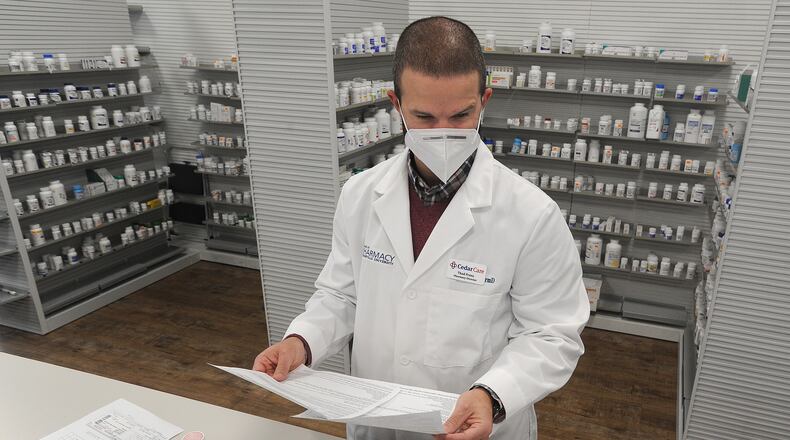“We were set up well in advance to be a provider of the vaccine in the state,” Franz said. “I’ve been working closely with the Greene County Health Department in regards to how fast they are getting their supply, and their feedback has just always been it’s been slow and they do not usually receive the amount that they’ve asked for so that always kind of helped guide me to think it might be more delayed than what I initially thought. I was encouraged when the retail pharmacy started to receive the supply, I was very hopeful that independent pharmacies would be soon thereafter.”
Cedar Care plans to work with the Cedar Cliff school district to vaccinate the employees there. The pharmacy would then be able to vaccinate other approved groups of people.
“We want to be a part of the solution for our community,” Franz said.
Ohio has said it’s getting the vaccines out as soon as they have them to providers. The problem appears to be the amount of supply.
Independents patiently waiting
Marcus Barr, who owns independent pharmacies in Xenia, Hillsboro and Sabina, said he and his team are “patiently waiting” to get the vaccine any day now.
“We’re at the ready,” Barr said.
Barr owns Barr’s Pharmacy in Xenia, Town Drug in Sabina and Downtown Drug of Hillsboro. He said in each of the pharmacies they have set up an appointment-based model to distribute the vaccines when they arrive in a quick and safe manner.
The pharmacists said they have been directing their patients to the Kroger’s and Walgreens in big cities or suburban areas in Ohio, like Dayton or Springfield.
“We’re just sitting here from the sidelines still and the big players are getting the vaccine and you hear stories about how its not really going well... I don’t know when we’ll get a chance to show what we can do,” Barr said.
The federal government announced that Walmart will be getting doses of the vaccine. The federal government selected Walmart because many of its stores are located in “medically underserved” and rural areas. Walmart is not yet vaccinating at its Ohio pharmacies.
Barr anticipates getting the vaccine in Ohio’s Phase II, but doesn’t know when that phase might start.
Barr said his three pharmacies get calls daily from patients looking for the vaccine or asking to be put on the pharmacy’s waitlist. Many of their patients don’t want to go to a crowded public place with hundreds of people sitting there and wait in a long line to get the vaccine.
“We know these folks and we see them a couple times a month usually, so it would be so easy for them to get the vaccine here and come visit us like they normally do,” Barr said. “We could fill that gap in rural America for sure.”
Franz said there are health resource deserts in rural areas and this has brought that fact to the forefront.
“We can’t forget about the independent doctor’s office that in that small town,” he said. “You’re going to find most of those independent pharmacies in those small rural towns are the most accessible health care professional there. You can walk into any pharmacy and get the attention of a pharmacist, without pay and without an appointment, there’s something to be said about that when we’re talking about the vaccine and vaccine education.”
Supplies limited
In rural communities that have gotten the vaccine, the amount of doses has been few and the supplies that come with vaccines vary.
“Not only are we not getting a large amount of vaccine, the consistency of the type of supplies they send with them, like syringes and needles, is very inconsistent,” said Brenda Reitz, pharmacy director for Family Health Services in Darke County.
Family Health Services is a federally qualified health center, Reitz said. The health center is getting some doses and they have partnered with the local health department, Wayne Hospital and Reid Hospital in Richmond, Indiana, to run one vaccine clinic. Reid Hospital provides space for the clinic at their building in Greenville. All together, the clinic is able to vaccinate about 300 people a week.
Reitz said they have been vaccinating people for about four weeks now and the youngest person they have vaccinated was 77-years-old.
“We just barely got through our 80-year-olds last week,” Reitz said. “We just don’t have enough vaccines available to vaccinate the population. We do have an old farming community.”
Reitz said a lot of the people who come to get vaccinated in Darke County can’t travel to a bigger city to get the COVID vaccine.
“I did have a customer say, ‘well, they’re vaccinating in Cincinnati.’ And I had to tell them that’s because they’re a larger city and they’re getting more vaccines,” Reitz said. “Some people are just getting a little frustrated. They’re very anxious.”
Getting vaccine out sooner
Franz, in Cedarville, said there are things that the state could have done differently when rolling out the vaccine, but he doesn’t know what obstacles stood in the way of getting vaccines into arms of Ohioans.
“Hindsight is 20-20, right?” Franz said.
Reitz said she thinks the state could use independent pharmacies to get the vaccine out more quickly. These pharmacies don’t have a corporate entity that they need to go through first, she said. It would also help to ship the vaccines directly to pharmacies or health centers. Reitz said in places like Darke County, with a large older population, a mobile vaccine clinic would be helpful for those who have trouble getting around.
“I have heard we’re moving that way. I think we’re moving in the right direction, but I think there needs to be more communication to these smaller communities as far as connecting doctor’s offices or pharmacies ,” Reitz said.
Barr pointed to Ohio’s neighbor West Virginia as having a successful vaccine rollout.
“I am not here to criticize these folks,” Barr said. “But there are other states doing better... West Virginia being one. They touch our state. so why aren’t we at least asking questions and trying to mimic (their vaccine rollout)?”
More than 12% of West Virginians are vaccinated. Less than 10% of Ohioans have been vaccinated, according to the Bloomberg vaccine tracker. Gov. Mike DeWine said the root of most of the challenges is essentially not enough vaccine. Supply is ramping up in Ohio and should continue to increase in the coming weeks. But for now, no central vaccine system exists in Ohio.
“We’re frustrated, but we so desperately want to help and be there for our community. The scope of this is monstrous,” Barr said. “We’d love to have our hand in helping. That’s what we do.”
About the Author

